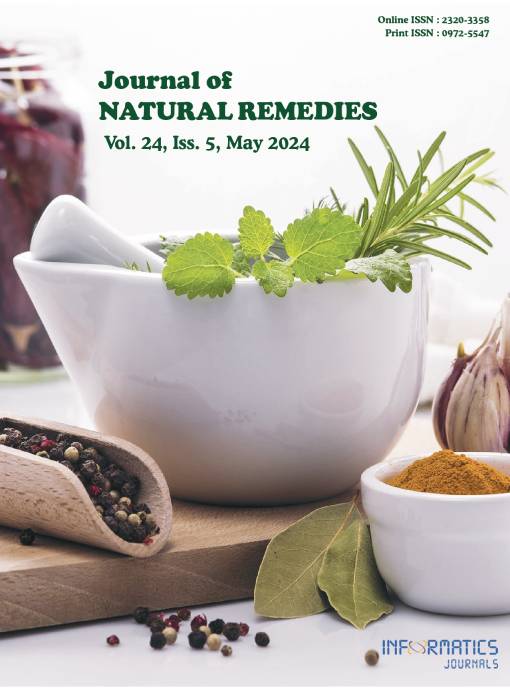Identification of Bioactive Molecules in Traditional Siddha Formulation “Nilaavarai Choornam”
DOI:
https://doi.org/10.18311/jnr/2024/35684Keywords:
Fluorescence Analysis, HPTLC Fingerprinting, Nilaavarai Choornam, Pharmacognostic, Phytochemical, Siddha SystemAbstract
The Siddha system of medicine is developed by ancient Tamil Siddhars, through their spiritual power. In the present work, the Siddha herbal formulation Nilaavarai choornam (NVC) is selected and chemically evaluated for its major active constituents. All standardization parameters were evaluated for the in-house and market samples of NVC. These parameters will also be useful in checking the quality of the ingredients and the end product. Its ingredients are senna, ginger, black pepper, ajowan and embelia. It is administered to treat constipation, indigestion, flatulence and intestinal worms. Pharmacognostic parameters of Nilaavarai choornam were determined through powder microscopy and chemical studies. Preliminary phytochemical screening was carried out using petroleum ether, chloroform, acetone, alcohol and water extracts obtained through successive extraction methods. Fluorescence analysis was also performed to detect chromophores present in this formulation. HPTLC Fingerprinting profile was determined to identify the active molecules present in this formulation. Powder microscopy of this formula suggested the presence of characteristic, calcium crystals, oleoresin, stone cells, endosperm cells, striated cuticle and parenchyma cells. The powdered material showed 2.8% loss on drying for NVC-M and 2.5% for NVC-H, 3% of ash for both samples and 0.54% of acid insoluble ash for NVC-M and 0.09% for NVC-H. Preliminary phytochemical screening of various extracts revealed the presence of proteins, sterols, terpenoids, carbohydrates, flavonoids, tannins, quinones, alkaloids and glycosides. The HPTLC fingerprinting profile of the chloroform fraction of NVC-M and NVC-H showed characteristic spots. Also, HPTLC determination was done with the standard gingerol and piperine and the results obtained confirmed the presence of active ingredients in both the samples.
Downloads
Metrics
Downloads
Published
How to Cite
Issue
Section
License
Copyright (c) 2024 S. Selva Sivagami, S. Abirami Swetha, V. Swetha, N. Ravichandran, R. Lavanya, P. Rajalakshmi, P. Brindha (Author)

This work is licensed under a Creative Commons Attribution 4.0 International License.
Accepted 2024-02-28
Published 2024-05-01
References
Sambasivam PTV. Tamil Dictionary Vol.1. 4th ed. Tamil Nadu Siddha Medical Council, Chennai. 1992.
Murugesa MKS, Gunapadam MV. 4th ed. Chennai: Tamil Nadu Siddha Medical Council. 1988.
The Siddha Formulary of India, Ministry of Health and Family Welfare, Department of AYUSH, Government of India. 1992.
Kuppusamy MKN, Uthamarayan KS. Siddha vaithiya thirattu, 1st ed, 2nd reprint. Chennai: Tamil Nadu Siddha Medical Council. 2009.
Thyagarajan R. Gunapadam Thaathu Jeeva Vaguppu, 4th ed. Chennai. Department of Indian Medicine and Homeopathy. 2004.
Madhavan R, Muthukumar NJ, Savariraj SC, Davidraj C, Sriram S, Rajalakshmi P, Brindha P. Studies on the safety profiles of a Siddha preparation – Thirithodamathirai. Biomedicine. 2022; 42(3):605-11. https://doi.org/10.51248/.v42i3.1242
Meenu B, Shyam BP. Embelia ribes are a valuable medicinal plant. J Chem Pharm Res. 2016; 8(4):1229-33.
Shabnam J, Ahmad AS, Muhammad SH, Aysha U, Rauf A and Sobia M. Nutritional, phytochemical potential and pharmacological evaluation of Nigella sativa (Kalonji) and Trachyspermum ammi (Ajwain). J Med Plant Res. 2012; 6(5):768-75. https://doi.org/10.5897/JMPR11.1341
Gayathri DV, Anitha J, Gopakumar K. Standardization of hinguvacadi churna an ayurvedic formulation and identification of piperine as a marker compound. J. Res. Educ. Indian Med. 2010; XVI(1-2):19-26.
Anonymous. Quality control methods for medicinal plant materials. Geneva: World Health Organization. 1988.
Krishnamurthy KV. Methods in plant histochemistry. Chennai: Viswanathan and Co. 1988.
Evans WC. Pharmacognosy. W.B. Saunders Company Ltd, 15th ed. 2002. p. 541-5.
Joshi S, Aeri V. Practical pharmacognosy. 1st ed. New Delhi: Frank Bros and Co. (Publishers) Ltd. 2009. p. 290-3.
The Ayurvedic Pharmacopoeia of India. Part I, Volume IV, New Delhi: Ministry of Health and Family Welfare, Department of AYUSH. 2004.
Harborne JB. Phytochemical methods, Chapman and Hall, London. 1973; 113.
Chase CR and Pratt RJ. Am Pharm Assoc Sci Ed. 1949; 38:324. https://doi.org/10.1002/jps.3030380612 PMid:18145471
Kasthuri OR and Ramesh B. Physicochemical and fluorescence analysis of leaves of Alternanthera brasiliana (L). Kuntze and Alternanthera bettzickiana (Regel) Voss. Int J Pharm Sci Rev Res. 2018; 51(1):66-71.
Sethi PD. HPTLC quantitative analysis of pharmaceutical formulations, CBS Publishers and distributors, New Delhi. 1996. p. 1-454.
Sujith T, Shakila R, Achintya KM, Kallingil GD, Mahesh F, Koppala NSK, Ganesan R. Powder microscopic, physicochemical, HPTLC and antioxidant studies on noccik kudinir chooranam – A polyherbal Siddha formulation. J Young Pharm. 2019; 11(4):371-6. https://doi.org/10.5530/jyp.2019.11.76
Karthi J, Kalvimoorthi V and Thamizh MM. Standardisation of Sudarshan churnaa polyherbal formulation. Int J Pharm Chem Biol Sci. 2012; 2(3):343-7.
Sitrarasi R and Razia M. Fluorescence analysis of leaf and root powders of Furcraea foetida (l.) haw. Journal of Emerging Technologies and Innovative Research. 2019; 6(1):495-8.
Vidhyatai J, Nikita W, Shubhada M, Milind W, Monika S. Applications of HPTLC in herbal drugs analysis. Indo American J Pharm Sci. 2022; 9(5):256-64.
Rakesh SS, Dheeraj HN, Sanjay UN. ‘HPTLC’ an important tool in standardization of herbal medical product: A review. J Sci and Innovative Res. 2013; 2(6):1086-96.
Ariamuthu S, Joy S, Vijayalakshmi R, Brindha P. Evaluation of an Ayurvedic compound formulation- Agnimukha curna. Indian J Tradit Knowl. 2007; 6(2):298-306.
Prawez A. Densitometric HPTLC analysis of 8-Gingerol in Zingiber officinal extract and ginger-containing dietary supplements, teas and commercial creams. Asian Pacific J of Tropical Biomed. 2013; 3(8):634-8. https://doi.org/10.1016/S2221-1691(13)60128-8 PMid:23905021
Anagha A, Rajopadhy, Anuradha US, Arvind MM. HPTLC method for analysis of piperine in fruits of piper species. J of Planar Chromatography. 2011; 24(1):57-9. https://doi.org/10.1556/JPC.24.2011.1.11

 S. Selva Sivagami
S. Selva Sivagami









 0.35
0.35 24
24 0.161
0.161